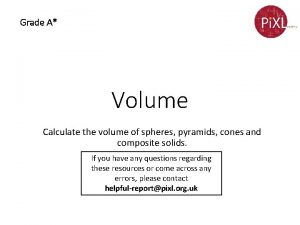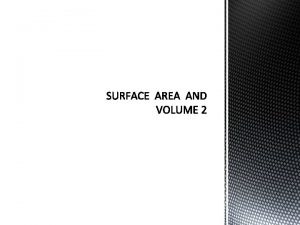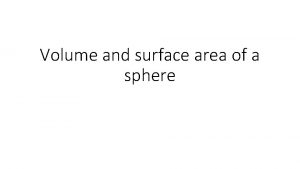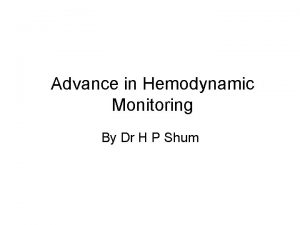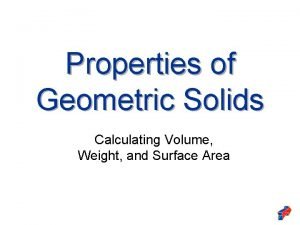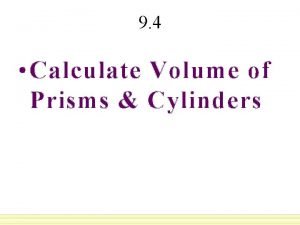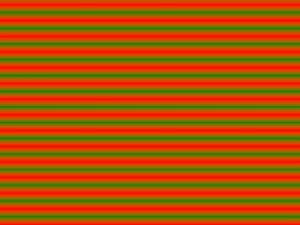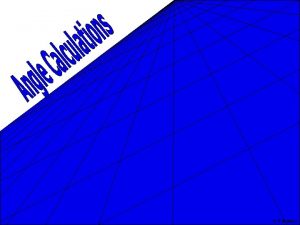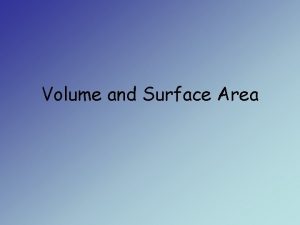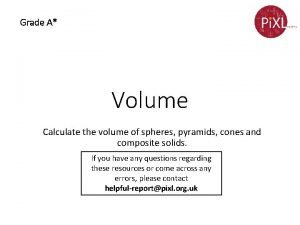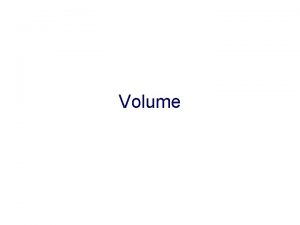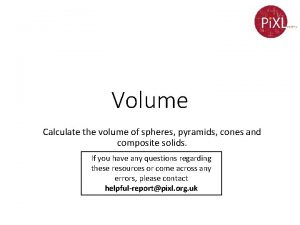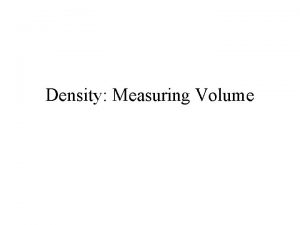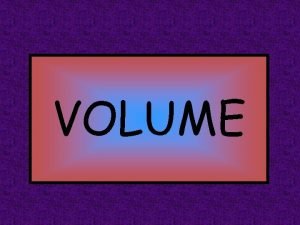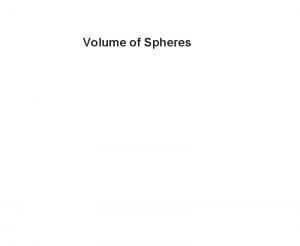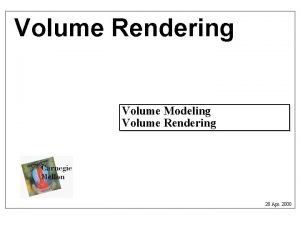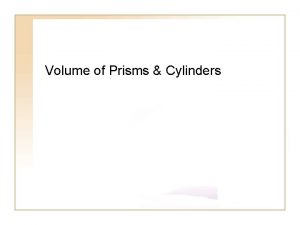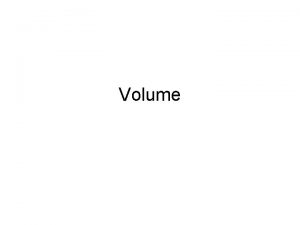T Madas T Madas Calculate the volume of

























































- Slides: 57

© T Madas

© T Madas

Calculate the volume of the following prism Method • Draw cross section 7 cm A 6 cm B 4 cm 10 cm 5 cm • Find cross - sectional area A : 6 x 12 = 72 cm 2 7 c B: 4 x 5= m 12 c m 20 cm 2 Total : 92 cm 2 6 cm 10 cm 12 cm • Calculate Volume m c 6 Volume : 92 x 6 = 552 cm 3 © T Madas

© T Madas

Calculate the volume of the following prism Method • Draw cross section 6 m B 9 m 5 m 3 m 3 m A 9 m 8 m 12 m 6 m 5 m • Find cross - sectional area A : 6 x 8 = 48 m 2 B: 3 x 3= 8 m 9 m 2 Total : 57 m 2 • Calculate Volume : 57 x 12 = 684 m 3 © T Madas

© T Madas

Calculate the volume of the following prism Method • Draw cross section 5 cm 4 cm 10 cm cm • Find cross - sectional area 8 5 cm 4 cm [10 + 4 ] x 5 2 = 35 cm 2 10 cm Trapezoidal prism • Calculate Volume : 35 x 8 = 280 cm 3 © T Madas

© T Madas

A cuboid is shown below. It has a square base with side length of 12 cm and a volume of 3600 cm 3. Calculate its surface area. 25 cm Volume = length x width x height h 12 cm 12 3600 = 12 x h 3600 = 144 x h h = 3600 ÷ 144 h = 25 cm cm © T Madas

A cuboid is shown below. It has a square base with side length of 12 cm and a volume of 3600 cm 3. Calculate its surface area. 25 cm Surface area = 4 x 25 x 4 = 400 cm 2 4 x 2 = 32 cm 2 12 cm 12 432 cm © T Madas

© T Madas

A tank without a lid is in the shape of a cuboid. It has a square base with side length of 60 cm and a capacity of 180 litres. Calculate its surface area. 1 litre = 1000 cm 3 50 cm 180 litres = 180000 cm 3 h Volume = length x width x height 180000 = 60 x h 60 cm 180000 = 3600 x h h = 180000 ÷ 3600 h = 50 cm © T Madas

A tank without a lid is in the shape of a cuboid. It has a square base with side length of 60 cm and a capacity of 180 litres. Calculate its surface area. 1 litre = 1000 cm 3 50 cm 180 litres = 180000 cm 3 60 cm Surface area = 60 x 50 x 4 = 12000 cm 2 60 x 60 = 3600 cm 2 15600 cm 2 © T Madas

© T Madas

C 1. 6 m B A A= B+b xh 2 2. 36 + 1. 94 A= x 1. 6 2 c 2. 36 m c A skip is in the shape of a prism with cross-section ABCD, AB = 1. 6 m, AD = 1. 94 m and BC = 2. 36 m. The width of the skip is 1. 8 m and there are right angles at A and B. 1. Calculate the area of ABCD. 2. Calculate the capacity of the skip 3. The weight of the empty skip is 700 kg. The skip is filled up to the top with sand. 1 m 3 of sand weighs 4500 kg. Calculate the total weight of the skip and the sand. A = 3. 44 m 2 1. 94 m 1. 8 m D © T Madas

A skip is in the shape of a prism with cross-section ABCD, AB = 1. 6 m, AD = 1. 94 m and BC = 2. 36 m. The width of the skip is 1. 8 m and there are right angles at A and B. 1. Calculate the area of ABCD. 2. Calculate the capacity of the skip 3. The weight of the empty skip is 700 kg. The skip is filled up to the top with sand. 1 m 3 of sand weighs 4500 kg. Calculate the total weight of the skip and the sand. Volume of a prism = x-sectional area x height/depth 2. 36 m C B V = 6. 192 m 3 1. 6 m A V = 3. 44 x 1. 6 1. 94 m 1. 8 m D Capacity is numerically equal to the volume © T Madas

A skip is in the shape of a prism with cross-section ABCD, AB = 1. 6 m, AD = 1. 94 m and BC = 2. 36 m. The width of the skip is 1. 8 m and there are right angles at A and B. 1. Calculate the area of ABCD. 2. Calculate the capacity of the skip 3. The weight of the empty skip is 700 kg. The skip is filled up to the top with sand. 1 m 3 of sand weighs 4500 kg. Calculate the total weight of the skip and the sand. Volume of a prism = x-sectional area x height/depth 2. 36 m C B + 1. 6 m A 6. 192 x 4500 = 27864 kg 700 kg 28564 kg 1. 94 m 1. 8 m D © T Madas

© T Madas

A trough in the shape of a triangular prism is shown below. It has a cross-sectional area of 0. 15 m 2 and its length is 2. 4 m. Calculate for this trough: a. its volume in m 3 b. its volume in cm 3 c. its capacity in litres (1 litre = 1000 cm 3) m 4. 2 0. 15 m 2 Volume = x-sectional area x height V = 0. 15 x 2. 4 = 0. 36 m 3 Convert 0. 36 m 3 into cm 3 1 m = 100 cm 1 m 3 =100 x 100 = 1, 000 cm 3 0. 36 m 3 = 0. 36 x 1000000 =360, 000 cm 3 = 360, 000 ÷ 1000 = 360 litres © T Madas

© T Madas

The prism shown below has an isosceles trapezium as its cross section. Find: (a) The volume of the prism (b) The total surface area of the prism B+b xh 2 26 + 10 x 15 A= 2 10 c A= c [All lengths are in cm] A = 270 cm 2 15 30 V = 270 x 30 V = 8100 cm 3 26 © T Madas

The prism shown below has an isosceles trapezium as its cross section. Find: (a) The volume of the prism (b) The total surface area of the prism [All lengths are in cm] 10 15 x 26 8 30 82 + 152 = x 2 64 + 225 = x 2 = 289 c c c 17 8 15 17 8 x = 17 © T Madas

The prism shown below has an isosceles trapezium as its cross section. Find: (a) The volume of the prism (b) The total surface area of the prism [All lengths are in cm] 10 270 x 2 = 540 17 x 30 x 2 = 1020 26 x 30 = 780 10 x 30 = 300 17 8 15 17 2640 cm 2 26 30 8 © T Madas

© T Madas

The figure below shows the cross section of a prism in the shape of a hexagon. 1. Calculate the area of the hexagon 2. Calculate the volume of the prism if its depth is 10 cm 8 cm 6 cm 12 cm © T Madas

The figure below shows the cross section of a prism in the shape of a hexagon. 1. Calculate the area of the hexagon 2. Calculate the volume of the prism if its depth is 10 cm. Area of the Hexagon = Rectangle – 4 right angled triangles = = = 6 cm x 4 x 3 12 x 8 – 4 x 1 2 96 – 24 72 cm 2 3 8 cm 4 72 cm 2 12 cm © T Madas

The figure below shows the cross section of a prism in the shape of a hexagon. 1. Calculate the area of the hexagon 2. Calculate the volume of the prism if its depth is 10 cm. Volume of a Prism = Cross-Sectional Area x Depth = 72 x 10 = 720 cm 3 cm 72 cm 2 10 8 cm 6 cm 12 cm © T Madas

© T Madas

The height of the prism is 1. 75 m. Calculate the volume of the prism correct to 3 significant figures. 1. 75 m A prism has a base in the shape of a regular hexagon. The hexagonal base has a side length of 1. 2 m © T Madas

0. 6 m 1. 2 m c x tan 30° = 0. 6 c 0. 6 tan 30° c x 30° x = tan 30° c opp = tanθ adj x= x ≈ 1. 03923 m A = 1 x 0. 6 x 1. 03923 ≈ 0. 3118 m 2 2 A ≈ 0. 6236 m 2 A ≈ 3. 7416 m 2 © T Madas

The height of the prism is 1. 75 m. Calculate the volume of the prism correct to 3 significant figures. 1. 75 m A prism has a base in the shape of a regular hexagon. The hexagonal base has a side length of 1. 2 m. 3. 7416 m 2 1. 2 m Volume of prism = base area x height V = 3. 7416 x 1. 75 = 6. 55 m 3 [ 3 s. f. ] © T Madas

Exam Question © T Madas

0. 6 m 2. 1 m A conservatory has the shape of a pyramid on top of a prism. The base of the prism and the base of the pyramid are regular hexagons of side length 1. 2 m. The height of the prism is 2. 1 m and the height of the pyramid is 0. 6 m. Calculate the volume of the conservatory correct to 3 significant figures. 1. 2 m © T Madas

0. 6 m 1. 2 m c x tan 30° = 0. 6 c 0. 6 tan 30° c x 30° x = tan 30° c opp = tanθ adj x= x ≈ 1. 03923 m A = 1 x 0. 6 x 1. 03923 ≈ 0. 3118 m 2 2 A ≈ 0. 6236 m 2 A ≈ 3. 7416 m 2 © T Madas

0. 6 m 3. 7416 m 2 2. 1 m A conservatory has the shape of a pyramid on top of a prism. The base of the prism and the base of the pyramid are regular hexagons of side length 1. 2 m. The height of the prism is 2. 1 m and the height of the pyramid is 0. 6 m. Calculate the volume of the conservatory correct to 3 significant figures. 3. 7416 m 2 1. 2 m © T Madas

Volume of pyramid = 1/3 x base area x height 0. 6 m Volume of prism = base area x height 3. 7416 m 2 V 1 = 3. 7416 x 2. 1 m = 7. 8574 m 3 1 x 3. 7416 x 0. 6 V 2 = 3 = 0. 7483 m 3 Total Volume = 8. 61 m 3 3. 7416 m 2 [ 3 s. f. ] 1. 2 m © T Madas

© T Madas

The figure below shows a prism in the shape of the letter H. Certain measurements are marked on the figure. 1. Show that the cross sectional area of the prism is 48 x 2 + 4 xy 2. Calculate the depth of the prism if its volume is 20 x 2(12 x + y ) Measurements in cm th p e 8 x A = 4 x ( 12 x + y ) V = 4 x ( 12 x + y ) x depth V = 4 x ( 12 x + y ) x 5 x y c c A = 3 x x 8 x + 4 x x y + 3 x x 8 x A = 24 x 2 + 4 xy + 24 x 2 A = 48 x 2 + 4 xy c c d 3 x 4 x 3 x © T Madas

© T Madas

The figure below shows a prism in the shape of the letter L. Measurements are marked on the figure in terms of x and y. 1. Show that the volume of the prism is 44 x 2 y 2. Evaluate this volume if x = 2 and y = 1. 5 4 x 5 x 7 x y 2 x 2 y 2 y 3 y 5 x y Measurements in cm A= A= V= V= 21 xy – 10 xy 11 xy x 4 x 44 x 2 y ccc 2 x © T Madas

4 x The figure below shows a prism in the shape of the letter L. Measurements are marked on the figure in terms of x and y. 1. Show that the volume of the prism is 44 x 2 y 2. Evaluate this volume if x = 2 and y = 1. 5 2 y 5 x y Measurements in cm A= A= V= V= 21 xy – 10 xy 11 xy x 4 x 44 x 2 y ccc 2 x © T Madas

4 x A= A= V= V= 21 xy – 10 xy 11 xy x 4 x 44 x 2 y ccc The figure below shows a prism in the shape of the letter L. Measurements are marked on the figure in terms of x and y. 1. Show that the volume of the prism is 44 x 2 y 2. Evaluate this volume if x = 2 and y = 1. 5 2 x 2 y 5 x y V = 44 x 22 x 1. 5 V = 44 x 1. 5 V = 264 cm 3 cc if x = 2 and y = 1. 5 Measurements in cm © T Madas

© T Madas

The nut shown below can be modelled as a hexagonal prism with a cylindrical hole in the centre. The side length of the nut is 8 mm, its height is 3 mm and the radius of the hole is 2. 5 mm Calculate the volume of the nut, correct to 3 significant figures. 2. 5 3 8 Measurements in mm © T Madas

The nut shown below can be modelled as a hexagonal prism with a cylindrical hole in the centre. The side length of the nut is 8 mm, its height is 3 mm and the radius of the hole is 2. 5 mm Calculate the volume of the nut, correct to 3 significant figures. area of the triangle m A = 1 x 8 x sin 60° 8 m 2 60° 60° 8 Measurements in mm 3 A = 32 sin 60° 8 mm area of the hexagon A = 6 x 32 sin 60° A = 192 sin 60° volume of the prism V = 192 sin 60° x 3 V = 576 sin 60° © T Madas

The nut shown below can be modelled as a hexagonal prism with a cylindrical hole in the centre. The side length of the nut is 8 mm, its height is 3 mm and the radius of the hole is 2. 5 mm Calculate the volume of the nut, correct to 3 significant figures. 3 8 Measurements in mm volume of the prism V = 576 sin 60° volume of the prism V = 192 sin 60° x 3 V = 576 sin 60° © T Madas

The nut shown below can be modelled as a hexagonal prism with a cylindrical hole in the centre. The side length of the nut is 8 mm, its height is 3 mm and the radius of the hole is 2. 5 mm Calculate the volume of the nut, correct to 3 significant figures. 2. 5 3 8 Measurements in mm volume of the prism V = 576 sin 60° © T Madas

The nut shown below can be modelled as a hexagonal prism with a cylindrical hole in the centre. The side length of the nut is 8 mm, its height is 3 mm and the radius of the hole is 2. 5 mm Calculate the volume of the nut, correct to 3 significant figures. 2. 5 3 8 Measurements in mm volume of the prism V = 576 sin 60° © T Madas

The nut shown below can be modelled as a hexagonal prism with a cylindrical hole in the centre. The side length of the nut is 8 mm, its height is 3 mm and the radius of the hole is 2. 5 mm Calculate the volume of the nut, correct to 3 significant figures. volume of a cylinder V = π r 2 h 2. 5 3 2 V = π x 2. 5 x 3 V = 18. 75 π Measurements in mm volume of the prism V = 576 sin 60° © T Madas

The nut shown below can be modelled as a hexagonal prism with a cylindrical hole in the centre. The side length of the nut is 8 mm, its height is 3 mm and the radius of the hole is 2. 5 mm Calculate the volume of the nut, correct to 3 significant figures. volume of a cylinder V = π r 2 h 2. 5 2 V = π x 2. 5 x 3 3 V = 18. 75 π 8 Measurements in mm volume of the prism V = 576 sin 60° © T Madas

The nut shown below can be modelled as a hexagonal prism with a cylindrical hole in the centre. The side length of the nut is 8 mm, its height is 3 mm and the radius of the hole is 2. 5 mm Calculate the volume of the nut, correct to 3 significant figures. volume of a cylinder V = π r 2 h 2. 5 2 V = π x 2. 5 x 3 3 V = 18. 75 π 8 Measurements in mm volume of the nut volume of the prism 576 sin 60° – 18. 75 π V = 576 sin 60° 440 mm 3 [ 3 s. f. ] © T Madas

© T Madas

The prism shown has a cross section of a circular sector of radius 8 cm corresponding to a central angle of 45°. The thickness of the prism is 3 cm. 1. Calculate the volume of the prism, correct to 3 s. f. 2. Calculate the surface area of the prism, correct to 3 s. f. area of a circle A = πr 2 A = π x 82 45° 3 cm 8 c m area of the given sector A = π x 8 2 x 45 360 volume of the prism 45° 8 cm V = π x 8 2 x 45 x 3 360 V = 24π V ≈ 75. 4 cm 3 [3 s. f. ] © T Madas

The prism shown has a cross section of a circular sector of radius 8 cm corresponding to a central angle of 45°. The thickness of the prism is 3 cm. 1. Calculate the volume of the prism, correct to 3 s. f. 2. Calculate the surface area of the prism, correct to 3 s. f. area of the given sector A = π x 8 2 x 45 360 45° 3 cm 8 c m area of the given sector A = π x 8 2 x 45 360 45° 8 cm © T Madas

The prism shown has a cross section of a circular sector of radius 8 cm corresponding to a central angle of 45°. The thickness of the prism is 3 cm. 1. Calculate the volume of the prism, correct to 3 s. f. 2. Calculate the surface area of the prism, correct to 3 s. f. area of the given sector x 2 A = π x 8 2 x 45 x 2 = 16π 2π r 45° 3 cm 360 area of the side rectangle x 2 8 c m A = 3 x 8 x 2 = 48 area of the curved surface A = 2 x π x 8 x 45 x 3 = 6π 360 45° 8 cm total surface area A = 16π + 48 + 6π ≈ 117 cm 2 [3 s. f. ] © T Madas

© T Madas

© T Madas
 Glycerin specific gravity
Glycerin specific gravity Find the volume
Find the volume Hemisphere surface area
Hemisphere surface area Hemisphere formula volume
Hemisphere formula volume Calculate tidal volume by height
Calculate tidal volume by height How to calculate density
How to calculate density Volume of trapezoidal prism formula
Volume of trapezoidal prism formula Advanced haemodynamic monitoring
Advanced haemodynamic monitoring Parallelogram prism surface area
Parallelogram prism surface area Weight=density*volume
Weight=density*volume Cylinder prism volume
Cylinder prism volume Volume of solute divided by volume of solution * 100
Volume of solute divided by volume of solution * 100 Volume kerucut = .....x volume tabung *
Volume kerucut = .....x volume tabung * Lung capacity
Lung capacity Stroke volume
Stroke volume Leaker test for parenterals
Leaker test for parenterals Preload stroke volume
Preload stroke volume Hình ảnh bộ gõ cơ thể búng tay
Hình ảnh bộ gõ cơ thể búng tay Sự nuôi và dạy con của hổ
Sự nuôi và dạy con của hổ Dot
Dot Biện pháp chống mỏi cơ
Biện pháp chống mỏi cơ Phản ứng thế ankan
Phản ứng thế ankan Trời xanh đây là của chúng ta thể thơ
Trời xanh đây là của chúng ta thể thơ Voi kéo gỗ như thế nào
Voi kéo gỗ như thế nào Thiếu nhi thế giới liên hoan
Thiếu nhi thế giới liên hoan điện thế nghỉ
điện thế nghỉ Vẽ hình chiếu vuông góc của vật thể sau
Vẽ hình chiếu vuông góc của vật thể sau Một số thể thơ truyền thống
Một số thể thơ truyền thống Thế nào là hệ số cao nhất
Thế nào là hệ số cao nhất Sơ đồ cơ thể người
Sơ đồ cơ thể người Các số nguyên tố là gì
Các số nguyên tố là gì đặc điểm cơ thể của người tối cổ
đặc điểm cơ thể của người tối cổ Mật thư tọa độ 5x5
Mật thư tọa độ 5x5 Các châu lục và đại dương trên thế giới
Các châu lục và đại dương trên thế giới Chụp phim tư thế worms-breton
Chụp phim tư thế worms-breton ưu thế lai là gì
ưu thế lai là gì Thẻ vin
Thẻ vin Tư thế ngồi viết
Tư thế ngồi viết Cái miệng bé xinh thế chỉ nói điều hay thôi
Cái miệng bé xinh thế chỉ nói điều hay thôi Các châu lục và đại dương trên thế giới
Các châu lục và đại dương trên thế giới Bổ thể
Bổ thể Từ ngữ thể hiện lòng nhân hậu
Từ ngữ thể hiện lòng nhân hậu Tư thế ngồi viết
Tư thế ngồi viết Ví dụ về giọng cùng tên
Ví dụ về giọng cùng tên Thơ thất ngôn tứ tuyệt đường luật
Thơ thất ngôn tứ tuyệt đường luật Chúa sống lại
Chúa sống lại Sự nuôi và dạy con của hổ
Sự nuôi và dạy con của hổ đại từ thay thế
đại từ thay thế Diễn thế sinh thái là
Diễn thế sinh thái là Vẽ hình chiếu vuông góc của vật thể sau
Vẽ hình chiếu vuông góc của vật thể sau 101012 bằng
101012 bằng Công thức tính thế năng
Công thức tính thế năng Thế nào là mạng điện lắp đặt kiểu nổi
Thế nào là mạng điện lắp đặt kiểu nổi Tỉ lệ cơ thể trẻ em
Tỉ lệ cơ thể trẻ em Lời thề hippocrates
Lời thề hippocrates Vẽ hình chiếu đứng bằng cạnh của vật thể
Vẽ hình chiếu đứng bằng cạnh của vật thể Quá trình desamine hóa có thể tạo ra
Quá trình desamine hóa có thể tạo ra

